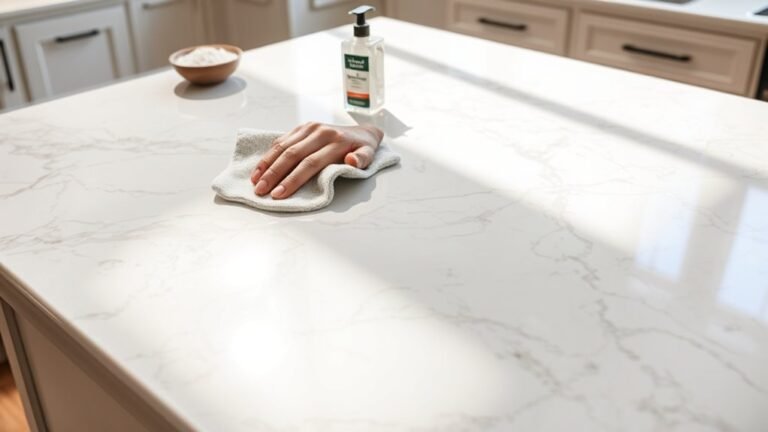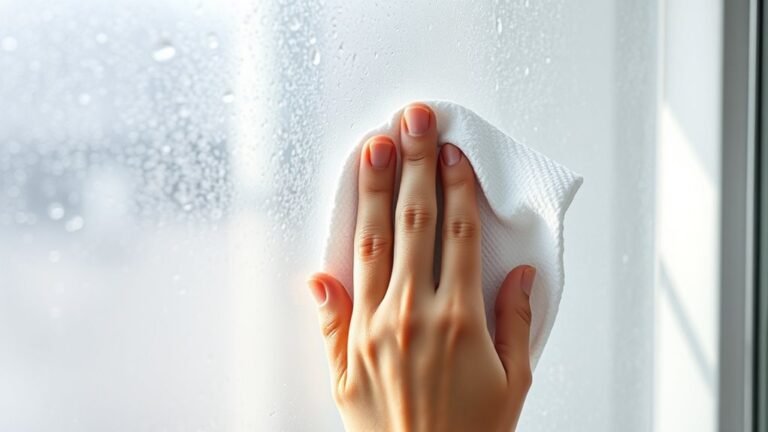Cleaning Techniques for Range Hood Owners
To keep your range hood spotless and efficient, start by safely removing the filters and soaking them in warm, soapy water to cut grease buildup. Use a gentle degreaser and a microfiber cloth to wipe the hood’s surface, avoiding harsh chemicals that damage finishes like stainless steel. Don’t forget to check and clean the vent and ductwork every few months to prevent blockages. If you stick with these basics, you’ll find it easier to maintain and troubleshoot your hood over time.
Understanding Different Types of Range Hoods

Before you start cleaning, it helps to know the type of range hood you have, since each one requires different care. There are several types of hoods, like under-cabinet, wall-mounted, island, and downdraft models. Each design affects how you access and clean it. Hood materials also matter—stainless steel is common and resists stains but shows fingerprints easily, while glass or painted finishes need gentler handling to avoid damage. Some hoods have removable filters and parts, making cleaning simpler, while others might require more attention to delicate components. Understanding these differences gives you the freedom to clean your hood effectively without risking damage. Knowing your hood’s type and material helps you choose the right approach, saving time and effort while keeping your kitchen fresh.
Tools and Supplies Needed for Cleaning
Since effective cleaning depends on having the right tools, you’ll want to gather a few essentials before you begin. Start with basic cleaning supplies like a gentle degreaser, microfiber cloths, and a soft-bristle brush. These will help you tackle grease without damaging your range hood’s surface. Essential tools also include a spray bottle for your cleaning solution and gloves to protect your hands. Avoid abrasive sponges or harsh chemicals that might limit your freedom to maintain your range hood safely. Having a small bucket or bowl handy makes rinsing easier. By preparing these cleaning supplies and essential tools ahead of time, you’ll guarantee your range hood stays fresh and functional, giving you the freedom to cook without worry.
How to Safely Remove and Clean Filters

Once you’ve gathered your cleaning supplies, the next step is to carefully remove the filters from your range hood. Proper filter removal guarantees you don’t damage the unit or yourself. Here’s how to do it safely and efficiently:
Carefully remove your range hood filters to avoid damage and ensure safe, effective cleaning.
- Turn off the range hood and unplug it for safety.
- Locate the filter latch or tabs holding the filter in place.
- Gently press or slide the latch to release the filter without forcing it.
- Carefully pull the filter downward or outward, depending on your model.
For filter cleaning, soak the filters in warm, soapy water or use a degreasing solution. After soaking, scrub gently with a soft brush, rinse thoroughly, and let them dry completely before reinstalling. This process keeps your range hood running freely and effectively.
Effective Methods for Degreasing the Hood Surface
Although cleaning the filters is essential, you shouldn’t overlook the hood’s exterior, where grease buildup can quickly accumulate. To keep things fresh and free, grab a grease cutting solution designed for kitchen surfaces. Spray it generously on the hood, let it sit for a few minutes, then wipe away with a soft cloth. For tougher spots, a gentle scrub with a non-abrasive sponge works wonders. Incorporate daily maintenance tips like quickly wiping down the hood after cooking to prevent grease from setting in. Avoid harsh chemicals that might damage the finish—stick to eco-friendly, effective cleaners. By regularly degreasing the hood surface, you’ll maintain a clean, inviting kitchen without the hassle, giving you the freedom to enjoy cooking without worrying about stubborn grease buildup.
Cleaning the Vent and Ductwork

When cleaning your range hood, don’t forget the vent and ductwork—they often collect grease buildup that can block airflow. You’ll want to inspect these areas carefully for any obstructions. Using the right tools will make removing grease and debris much easier and more effective.
Removing Grease Buildup
Because grease buildup in your range hood’s vent and ductwork can restrict airflow and cause unpleasant odors, it’s important to clean these areas regularly. Keeping up with grease removal not only boosts performance but also gives you the freedom to cook without worries. Here’s how to tackle it effectively:
- Set a consistent cleaning frequency—ideally every 3 to 6 months depending on cooking habits.
- Use a degreaser spray designed for kitchen vents to break down stubborn grease.
- Wear gloves and a mask to protect yourself from fumes and residue.
- Wipe down surfaces with a microfiber cloth, ensuring you reach deep into the ducts.
Inspecting for Blockages
How can you be sure your range hood is working at its best? Regularly inspecting for blockages in the vent and ductwork is key to maintaining its efficiency and your freedom from kitchen odors and smoke. Watch for blockage indicators like reduced airflow, unusual noises, or lingering cooking smells. These signs mean it’s time to check the vent system. Set an inspection frequency that fits your cooking habits—monthly if you cook often, or quarterly for lighter use. During inspection, look for debris buildup, nests, or grease clogs that restrict airflow. Staying proactive with these checks keeps your range hood performing smoothly, giving you the freedom to cook without worry and enjoy a fresh kitchen environment.
Using Proper Cleaning Tools
Three essential tools can make cleaning your range hood’s vent and ductwork easier and more effective. Your cleaning frequency depends on how often you cook, but having the right tools guarantees you’re ready whenever dirt builds up. Smart tool selection saves time and effort, freeing you from complicated maintenance.
Here are four must-have tools for the job:
- Flexible brush – reaches deep inside ducts to remove grease and debris.
- Vacuum with a hose attachment – sucks up loosened dirt efficiently.
- Microfiber cloths – perfect for wiping accessible surfaces without scratching.
- Screwdriver set – helps you remove panels or covers safely for thorough cleaning.
Using these tools regularly keeps your vent clear, boosting airflow and your kitchen’s freedom from smoke and odors.
Maintaining Your Range Hood Regularly
Although it might seem like a small task, maintaining your range hood regularly is crucial for keeping it running efficiently and preventing grease buildup. Setting up a consistent cleaning schedule helps you stay on top of maintenance without feeling overwhelmed. Aim to clean the filters and wipe down surfaces every few weeks, depending on your cooking frequency. Simple maintenance tips, like using warm soapy water for grease and checking the fan’s performance, can make a big difference. By committing to these small, regular actions, you’ll guarantee your range hood works smoothly, improving air quality and extending its lifespan. Taking control of your cleaning schedule puts the freedom in your hands, so you’re never stuck with a clogged or inefficient range hood.
Troubleshooting Common Range Hood Issues
Keeping up with regular maintenance helps prevent many common problems, but sometimes your range hood might still act up. When that happens, don’t stress—here are some practical troubleshooting tips to get you back in control:
Regular upkeep prevents issues, but if your range hood misbehaves, these troubleshooting tips will help you fix it quickly.
- Hood not turning on: Check the power supply and reset any tripped breakers.
- Weak suction: Clean or replace greasy filters to restore airflow.
- Loud noise: Tighten loose screws or inspect the fan for debris.
- Lights flickering: Replace bulbs or check wiring connections.
Frequently Asked Questions
How Often Should I Replace My Range Hood Filters?
You might think timing your filter maintenance is tricky, but it’s actually pretty straightforward. If you cook often or fry a lot, your replacement schedule should be every 3 to 6 months. Otherwise, changing filters twice a year usually does the trick. Keeping up with this routine frees you from greasy buildup and keeps your kitchen air fresh. So, stick to this simple plan, and you’ll enjoy worry-free ventilation.
Can I Use Natural Cleaners Instead of Chemical Degreasers?
You can totally use natural cleaning products instead of harsh chemical degreasers. Natural cleaning solutions like vinegar, baking soda, and lemon juice are not only effective but also eco-friendly solutions that keep your space fresh without harmful fumes. If you want freedom from toxic chemicals and a safer home environment, these natural cleaners are your go-to. They’re simple, affordable, and gentle on your range hood, making maintenance hassle-free and green.
What Should I Do if My Range Hood Makes Loud Noises?
If your range hood suddenly starts singing a loud, unexpected tune, it’s time for some noise troubleshooting. You’ll want to give it a little tender loving care through proper range hood maintenance—check if the fan blades are loose or if debris is causing the ruckus. Tighten screws and clean filters to keep things running smoothly. Taking these steps helps you reclaim the peaceful freedom of your kitchen space without unnecessary noise.
Are There Any Risks of Cleaning My Range Hood Too Frequently?
You might wonder if cleaning frequency could cause problems. While regular upkeep is key, cleaning your range hood too often can wear down parts or damage filters. It’s all about balance—stick to maintenance tips like checking grease buildup monthly and deep-cleaning every few months. This way, you keep your hood efficient without unnecessary wear. Trust your instincts, but don’t overdo it; freedom means smart choices, not constant fussing.
Can Improper Cleaning Void My Range Hood’S Warranty?
Yes, if you don’t follow the cleaning guidelines provided by the manufacturer, you might risk voiding your range hood’s warranty coverage. They often specify which cleaning methods and products are safe to use, so ignoring those can cause damage or void protection. To keep your freedom to use your warranty when needed, stick to the recommended cleaning techniques and avoid harsh chemicals or abrasive tools that could harm the unit.






